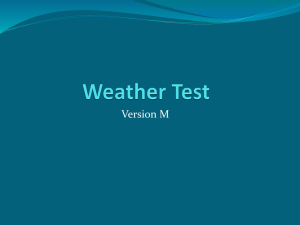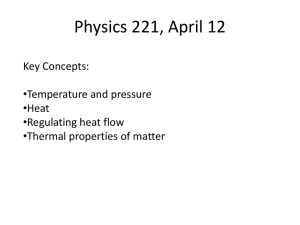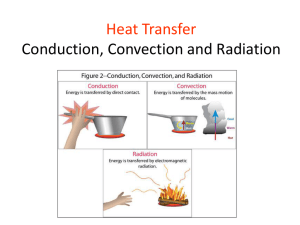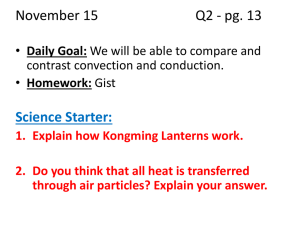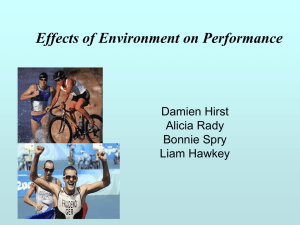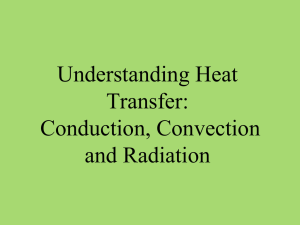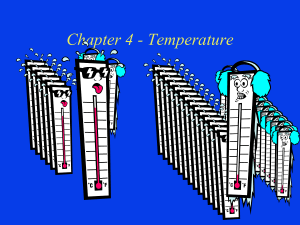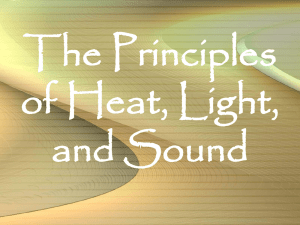Temperature Microscales
advertisement
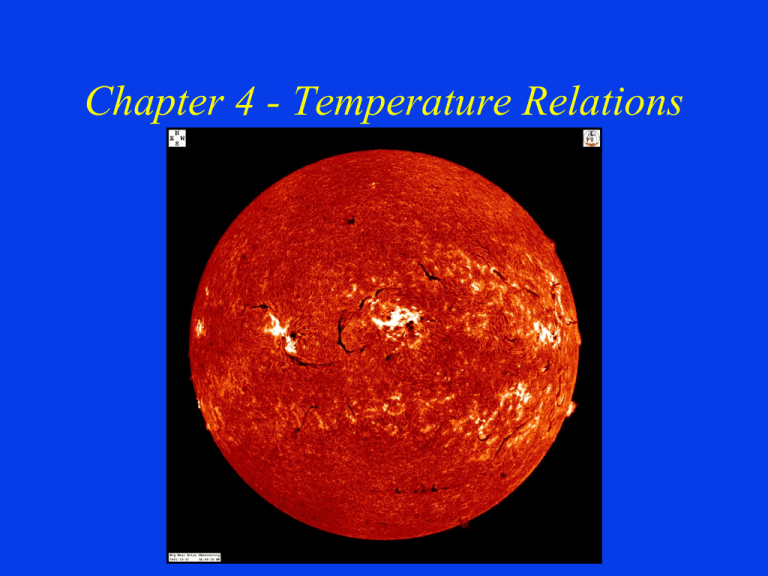
Chapter 4 - Temperature Relations CNN is reporting that a chunk of ice shelf nearly the size of Manhattan has broken away from Ellesmere Island in Canada's northern Arctic. Just last month 21 square miles of ice broke free from the Markham Ice Shelf. Scientists are saying that Ellesmere Island has now lost more than 10 times the ice that was predicted earlier this summer. Question of the Day If the arctic ice cap melts completely, Then, what do you think will be the worst thing that will happen to the global ecology? Chapter 4 - Temperature Relations Objectives: 1. List reasons why differences in temperature exist on a microscale 2. Explain why organisms perform best in a narrow range of temperature 3. Describe how organisms compensate for variations in environmental temperatures Chapter 4 - Temperature Relations Objectives: 4. Define resting stages and their applications 5. Identify where heat comes from and where is goes!!! Temperature Microscales Temperature Microscales Cool Hot Fig. 4.3 Fig. 4.1 Temperature Microscales 1. Altitude: temperatures decrease as altitude increases 2. Aspect: Shading parts of the land e.g., “North Facing Slope” and ski areas Temperature Microscales 3. Vegetation: Plants create microclimate Temperature Microscales 4. Color: e.g., ground Coolest Warmest Solar Radiation Temperature Microscales 5. Boulders, burrows, or any other landscape feature that absorbs, reflects, or alters the sun’s radiant energy, alters temperature. Temperature Microscales 6. Aquatic habitats: • Evaporation of water surfaces cools “Latent heat of vaporization” - absorbs heat as it evaporates • Freezing “Latent heat of fusion” gives up heat energy to the environment • Thermal stability of water is greater than air Fig. 4.7 What do we know so far? 1. Temperature can change dramatically over a very small distance. 2. Organisms may cause this change (e.g., plant and shade). 3. Colors, and other landscape features drive this change. 4. Aquatic Environments more resistant to changes in temperature. 2nd Question of the Day!! “Micro” infers a very small area. Define how big this is (using a metric scale) defending your answer with examples. Temperature Effects Range of Tolerance Environmental range of biological processes: Minimum Temperature 0C Maximum Temperature 40 C Optimum Temperature* 20-40 C * different for each organism Temperature Effects Death at High Temperatures: Primary cause is the denaturing of enzyme proteins necessary for metabolism Death at Low Temperatures: Formation of ice crystals within cells, rupturing membranes Temperature Effects Between the Extremes: Temperature affects the organisms by controlling the rates of enzyme reactions in metabolic pathways!! Fig. 4.10 Law of Tolerance Shelford (1913) “There are upper and lower bounds to physical factors that an organism can tolerate” Law of Tolerance Fig. 4.10 Adaptations Temp. Variations Organisms must regulate temperature (if possible) for optimum growth. How? They can gain or lose heat in a variety of ways Physics of Energy Exchange • • • • Radiation (Electromagnetic) Conduction Convection Evaporation Radiation Transfer of energy through electromagnetism • Every object emits radiation • Amount and type depends on the temperature of object • Does not require the presence of matter • Living organisms absorb solar radiation in the visible light range, and radiate energy as heat Conduction Movement of heat through matter FROM: region of high temperature TO: region of low temperature RATE: proportional to gradient proportional to surface area conductivity of material inversely proportional to distance Convection Transfer of heat by the circulation of a fluid-liquid or gas Wind Chill Convection Transfer of heat by the circulation of a fluid-liquid or gas WC = 91.4 - (0.474677 0.020425 * V + 0.303107 * SQRT(V)) * (91.4 - T) where: WC = wind chill index V = wind speed (mph) T = temperature (° F) Evaporation Heat energy dissipated by converting water from liquid to gas: e.g., sweat, evapotranspiration 539 kcal of heat consumed to covert one kg of water from liquid to vapor Latent Heat of Vaporization Thermal Budgets If: an organism absorbs more energy than it emits or stores in chemical bonds Then: Temperature increases If: an organism absorbs less energy than it emits or releases from chemical bonds Then: Temperature decreases Temperature - The Formula Hs = Hm + Hcd + Hcv + Hr + He Where: Hs = Total heat stored in body Hm= Heat gained from metabolism Hcd = Heat gained or lost from conduction Hcv = Heat gained or lost from convection Temperature - The Formula Hs = Hm + Hcd + Hcv + Hr + He Where: Hr = Heat gained or lost through electromagnetic radiation He = Heat lost through evaporation Fig. 4.14 Thermal Regulation How do organisms regulate temperature? Have we answered this question? Subject of lecture next Tuesday What did we learn today? • Microclimates • Types of energy and heat transfer • Minimum, maximum and optimum temperatures • Read Chapter 4 for next Tuesday-------Chapter 4 Temperature Thermal inputs - Generating Heat!!: Direct sunlight Diffuse solar radiation Heat radiation from surroundings Conduction from environment Heat of metabolism Temperature Thermal Outputs - Losing Heat!!!!: Longwave radiation to surroundings Conduction to environment Convection Evaporation


